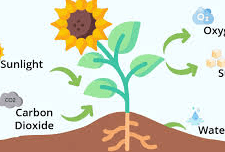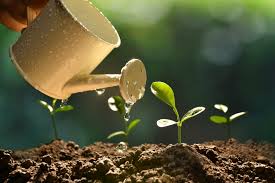Plant growth and development are fundamental processes that enable plants to thrive and reproduce. This guide covers the key stages of plant development, the role of photosynthesis, soil and nutrient requirements, the impact of water, and environmental factors affecting growth.
Plant growth is a complex process involving the increase in size and mass of plants. It encompasses both cell division and cell enlargement. Growth occurs at specific regions known as meristems, which are located at the tips of roots and shoots. These areas are responsible for producing new cells and tissues.
Plant growth is influenced by genetic factors and environmental conditions, enabling plants to adapt to their surroundings and fulfill their ecological roles.
Key Stages of Plant Development
1. Germination: Germination is the initial stage where a seed absorbs water, swells, and begins to grow. The seed coat breaks open, and the embryo starts to develop roots, stems, and leaves. Proper temperature, moisture, and oxygen are crucial for successful germination.
2. Seedling Stage: In this stage, the young plant (seedling) begins to develop its first true leaves and establish a root system. The plant starts to photosynthesize and requires ample light, water, and nutrients to support rapid growth.
3. Vegetative Growth: During vegetative growth, the plant focuses on developing its stems, leaves, and roots. This stage is critical for building the plant’s structure and energy reserves. Healthy leaves and roots contribute to efficient nutrient and water uptake.
4. Reproductive Stage: The reproductive stage involves flowering and seed production. Flowers are formed, pollination occurs, and seeds are produced for the next generation. This stage is crucial for the plant’s reproduction and species survival.
5. Maturation and Senescence: In the maturation stage, the plant reaches its full size and completes its life cycle. Senescence is the final stage where the plant undergoes aging, and its leaves and stems begin to deteriorate. The plant may eventually die, completing its life cycle.
Photosynthesis and Its Role in Growth

1. Photosynthesis Process: Photosynthesis is the process by which plants convert light energy into chemical energy. This occurs in the chloroplasts of plant cells, where chlorophyll captures sunlight and uses it to transform carbon dioxide and water into glucose and oxygen. The glucose produced is used as an energy source for growth and development.
2. Importance for Growth: Photosynthesis is essential for plant growth as it provides the primary source of energy. The glucose produced during photosynthesis fuels cellular processes, supports new tissue formation, and contributes to overall plant health. Adequate light, water, and nutrients are necessary for efficient photosynthesis and optimal growth.
Soil and Nutrient Requirements
1. Soil Composition: Soil provides the foundation for plant growth, supplying essential nutrients, water, and support. It is composed of minerals, organic matter, air, and water. Healthy soil has a balanced structure and good drainage.
2. Nutrient Needs: Plants require various nutrients for growth, including macronutrients like nitrogen (N), phosphorus (P), and potassium (K), as well as micronutrients such as iron, magnesium, and calcium. These nutrients support key functions like protein synthesis, energy transfer, and root development.
3. Soil Testing: Regular soil testing helps determine nutrient levels and pH, guiding appropriate fertilization and soil management practices. Adjustments can be made to ensure that plants receive the right balance of nutrients for healthy growth.
Water and Its Impact on Growth
1. Water Absorption: Water is essential for plant growth as it is involved in nutrient uptake, photosynthesis, and temperature regulation. Plants absorb water through their roots from the soil.
2. Impact of Water Supply: Adequate water is crucial for maintaining cell turgor pressure, which supports plant structure. Water stress, whether from drought or waterlogging, can lead to stunted growth, reduced photosynthesis, and poor plant health. Proper irrigation practices are necessary to ensure consistent water availability.
3. Water Management: Efficient water management involves using methods such as drip irrigation or rainwater harvesting to provide the right amount of water without waste. Monitoring soil moisture and adjusting watering schedules based on plant needs and environmental conditions help optimize growth.
Read Also: 15 Healing Powers of Scent Leaf (Ocimmum gratissimum)
Environmental Factors Affecting Growth

1. Light: Light is a vital factor for photosynthesis. Plants require appropriate light intensity and duration to grow effectively. Too little light can lead to poor growth and weak plants, while excessive light can cause damage. Light quality, including the balance of blue and red wavelengths, also affects plant development.
2. Temperature: Temperature influences enzyme activity and metabolic processes in plants. Most plants have an optimal temperature range for growth. Extreme temperatures, whether too hot or too cold, can stress plants and affect their development. Frost, for example, can damage plant tissues and impede growth.
3. Humidity: Humidity affects water loss through transpiration. High humidity can reduce water loss and improve plant health, while low humidity can lead to increased transpiration and water stress. Maintaining appropriate humidity levels is essential for preventing issues like leaf curl and poor growth.
4. Carbon Dioxide: CO₂ is a critical component of photosynthesis. Higher atmospheric CO₂ levels can enhance photosynthesis and growth in some plants, but this effect can be influenced by other factors such as nutrient availability and water supply.
Hormones and Growth Regulators
1. Plant Hormones: Plant hormones, also known as phytohormones, are chemical substances that regulate various aspects of plant growth and development. Key hormones include:
Auxins: These hormones promote cell elongation and are crucial for root and shoot development. They help plants respond to light and gravity, guiding growth direction.
Gibberellins: Gibberellins stimulate cell division and elongation, affecting plant height and seed germination. They are vital for flowering and fruit development.
Cytokinins: These hormones promote cell division and bud formation. They work in conjunction with auxins to regulate growth and influence the development of shoots and roots.
Abscisic Acid (ABA): ABA is involved in stress responses, including drought tolerance and seed dormancy. It helps plants manage water loss and adapt to adverse conditions.
Ethylene: Ethylene influences fruit ripening, leaf abscission (drop), and stress responses. It plays a role in regulating plant responses to mechanical stress and pathogens.
2. Growth Regulators: Growth regulators are synthetic chemicals used to influence plant growth. They mimic natural hormones and are used in agriculture and horticulture to control plant development. Examples include:
Growth Inhibitors: These regulate growth by slowing down cell division and elongation, often used to manage plant size and shape.
Rooting Hormones: Applied to cuttings, these hormones promote root development, aiding in plant propagation.
The Role of Genetics in Plant Growth
1. Genetic Influence: Genetics play a significant role in determining plant growth patterns, size, shape, and yield. Genetic makeup influences how plants respond to environmental conditions and stresses.
2. Selective Breeding: Through selective breeding, specific traits can be enhanced or introduced in plants. This involves choosing parent plants with desirable characteristics and breeding them to produce offspring with improved traits, such as disease resistance or higher productivity.
3. Genetic Modification: Genetic modification (GM) involves altering a plant’s DNA to introduce new traits or enhance existing ones. GM plants can exhibit traits like pest resistance or improved nutrient content, contributing to more efficient and resilient crops.
4. Genomic Studies: Advances in genomic research help scientists understand the complex interactions between genes and growth processes. Genomic tools enable the identification of genes associated with growth traits, leading to more precise breeding and genetic engineering efforts.
Read Also: Causes of Diseases in Farm Animals and How to Prevent Disease OutBreak
Common Growth Issues and Solutions

1. Nutrient Deficiencies: Plants may exhibit signs of nutrient deficiencies, such as yellowing leaves or poor growth. Solution: Conduct soil tests to identify nutrient imbalances and apply appropriate fertilizers to correct deficiencies.
2. Water Stress: Both overwatering and underwatering can harm plant growth. Solution: Monitor soil moisture levels and adjust watering practices accordingly. Use irrigation systems that provide consistent moisture without waterlogging.
3. Pest and Disease Problems: Pests and diseases can hinder plant growth and damage crops. Solution: Implement integrated pest management (IPM) strategies, including biological control, chemical treatments, and cultural practices to manage pests and diseases effectively.
4. Environmental Stress: Extreme temperatures, poor light conditions, and humidity fluctuations can affect plant growth. Solution: Adjust growing conditions, such as providing shade, using greenhouses, or implementing climate control measures to create optimal growth environments.
Techniques to Enhance Plant Growth
1. Soil Improvement: Enhancing soil quality by adding organic matter, such as compost, improves nutrient availability and soil structure. Well-aerated, nutrient-rich soil supports healthy root development and overall plant growth.
2. Fertilization: Applying balanced fertilizers ensures plants receive essential nutrients for optimal growth. Choose fertilizers based on plant needs and soil test results, and apply them according to recommended rates and schedules.
3. Pruning and Training: Regular pruning removes dead or diseased parts of plants and encourages new growth. Training techniques, such as staking or trellising, help plants grow in desired shapes and improve air circulation and light exposure.
4. Proper Watering: Implement efficient watering practices, such as drip irrigation or rainwater harvesting, to provide consistent moisture. Avoid overwatering and ensure proper drainage to prevent root rot and other water-related issues.
5. Environmental Control: Use techniques such as mulching, shading, and climate control to manage environmental conditions and protect plants from extreme temperatures and other stress factors.
Understanding plant growth involves exploring the role of hormones and growth regulators, the impact of genetics, and addressing common growth issues with effective solutions. By employing techniques to enhance growth, such as soil improvement, proper watering, and environmental control, gardeners and farmers can support healthy plant development and optimize their yield. This knowledge is essential for successful plant cultivation and contributes to sustainable agriculture and gardening practices.
Read Also: Grocery Gang: Everything You Need to Know

